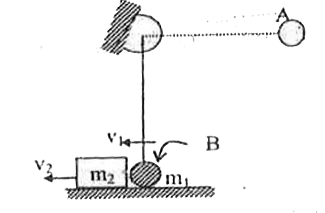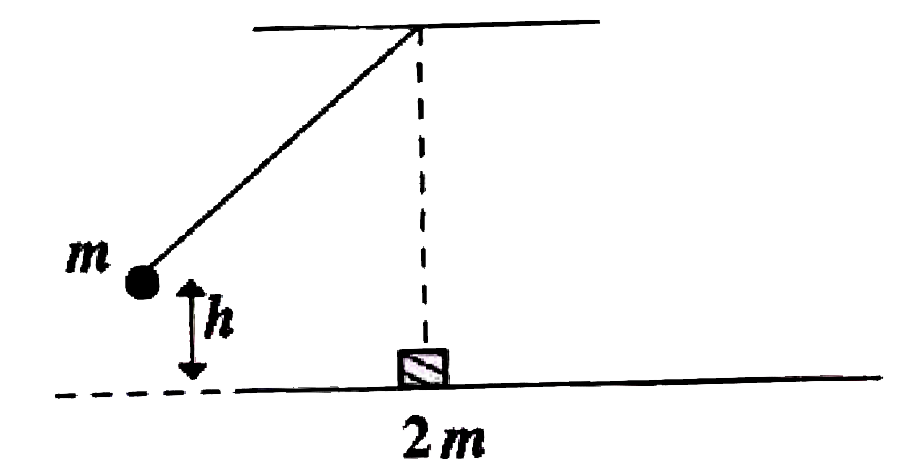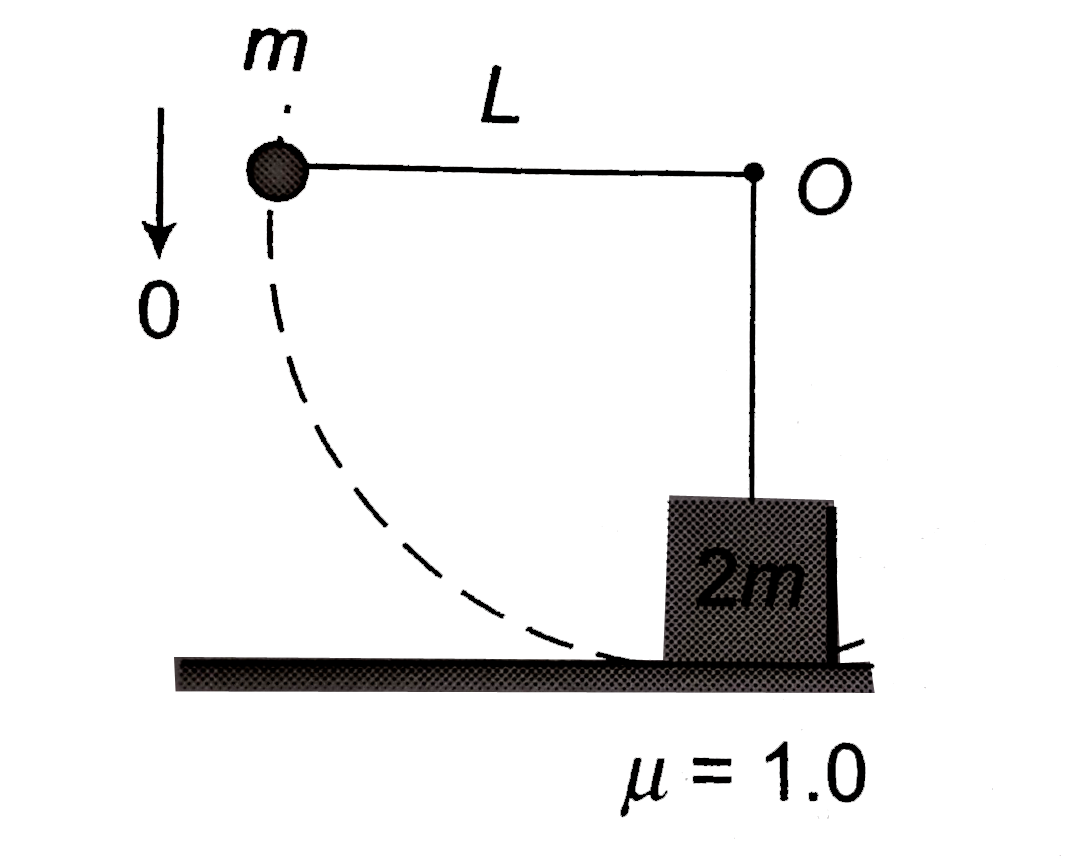A steel ball of mass 0.5kg is fastened to a cord 20cm long and fixed at the far end and is released when the cord is horizontal. At the bottom of its path the ball strikes a 2.5kg steel block initially at rest on a frictionless surface. The collision is elastic. The speed of the block just after the collision will be.
Let the ball strike the block with a speed u1. Since the initial speed (speed before collision) of the block =u2=0 for the perfectly elastic collision, the speed of the block is given as
v2=2m1m1+m2u1=2m1m2m1m2+1u1
where u1 can be found by conserving energy of the ball between the position A and B before collision of m1.
⇒12m1u21−m1gl=0
⇒u1=√2gl=√2×10×20=20 m/sec.
m1m2=0.5kg2.5kg=15
By putting u1=20 m/sec and m1m2=15 in (a) we obtain
v2=⎧⎨⎩215+1⎫⎬⎭{15}(20)=203m/s

Topper's Solved these Questions
- BOOK - FIITJEECHAPTER - COLLISION EXERCISE - SOLVED PROBLEMS (OBJECTIVE)18videos
COLLISION
- BOOK - FIITJEECHAPTER - COLLISION EXERCISE - SOLVED PROBLEMS (OBJECTIVE) ASSERTION REASONING TYPE1videos
COLLISION
- BOOK - FIITJEECHAPTER - COLLISION EXERCISE - (NUMERICAL BASED QUESTIONS)4videos
COLLISION
- BOOK - FIITJEECHAPTER - AC CIRCUITSEXERCISE - ASSERTION REASONING TYPE1videos
AC CIRCUITS
- BOOK - FIITJEECHAPTER - CURRENT ELECTRICITYEXERCISE - Comprehension -43videos
CURRENT ELECTRICITY
Similar Questions
A steel ball weighting 1 kg is fastened to a cord 1 m long and is released when the cord is horizontal . At the bottom of its path the ball strikes a 5-kg steel block initially at rest on a frictionless surface . The collision is elastic . Find the speed of the ball and speed of the block just after collision . (g = 9.8ms−2)
[Hint : Apply principal of conservation of momentum and conservation of kinetic energy as the collision is elastic .]View SolutionTwo balls having masses m and 2m are fastened to two light strings of same length l figure. The other ends of the strings are fixed at O. The strings are kept in the same horizontal line and the system is released from rest. The collision between the balls is elastic. a. Find velocities of the balls just after their collision. b. How high will the balls rise after the collision.
 View Solution
View Solution
Knowledge Check
- Question 1 - Select One
A bullte weighing 5g and moving with a velocity 600m/s strikes a 5kg block of ice resting on a frictionless surface. The speed of the block after the collision is
A6cm/sB60cm/sC6m/sD0.6cm/s - Question 2 - Select One
A bullet weighing 10 gm and moving at 300 m/s strikes a 5 kg ice and drops dead. The ice block is placed on a frictionless level surface. The speed of the block after the collision, is
A6 cm/secB6 m/secC60 cm/secD60 m/sec - Question 3 - Select One
A ball of mass m suspended from a rigid support by an inextensible massless string is released from a height h above its lowest point. At its lowest point it collides elastically with a block of mass 2m at rest on a frictionless surface. Neglect the dimensions of the ball and the block. After the collision the ball rises to a maximum height of–
 Ah/3Bh/2Ch/8Dh/9
Ah/3Bh/2Ch/8Dh/9
A glass ball collides with an identical ball at rest with v0=2 m/sec. If the coefficient of restitution of collision is e = 0.5, find the velocities of the glass balls just after the collision.
View SolutionA buttle weighting 10 g and moving with a velocity 800ms−1 strikes a 10 kg block resting on a frictionless surface. The speed of the block after the perfectly inelastic collision is approximately
View SolutionA bullet weighing 10 g and moving with a velocity 300 m/s strikes a 5 kg block of ice and drop dead. The ice block is kept on smooth surface. The speed of the block after the the collision is
View SolutionThe ball is released when the string is horizontal. The collision between the ball and the block is head - on elastic. The velocities of the ball and the block immediately after collision
 View Solution
View SolutionTwo balls each of mass 2kg (one at rest) undergo oblique collision is perfectly elastic, then the angle between their velocities after collision is
View Solution

